 |
 |
 |
| |
16 vs 24 wks Pegasys/RBV in Cirrhotics & Non-Cirrhotics Genotype 2/3 from ACCELERATE Study
|
| |
| |
Almost every presentation at DDW that is of keen interest was presented at EASL, there is not much new presented here at DDW. In particular the newest data on new HCV drugs and presentations on new treatment findings with current HCV treatment of peginterferon plus ribavirin were presented at EASL. This year's EASL dominated the landscape in terms of information presented there and perhaps in the future EASL will take on a new prominence in the presentation of new data in HCV and HBV, particularly with the development of new HCV drugs, and this era of emerging new HCV drugs will be ongoing for many years. HOWEVER, this presentation which is a substudy from the ACCELERATE Trial is new, it was NOT presented at EASL. In brief, Accelerate results report: that for patients with a Rapid Viral Response (RVR) for non-cirrhotics 24 weeks Pegasys/RBV provides 91% SVR rate vs 85% for 16 weeks therapy. While for cirrhotic patients 24 weeks Pegasys/RBV provided 87% SVR rate vs 71% for 16 weeks. These results suggest that for patients with compensated cirrhosis 24 weeks therapy provides much better results (87% vs 71%). But for patients without compensated cirrhosis 16 weeks and 24 weeks therapy both provide good results, although 24 weeks therapy appears to yield better results in this study (91% vs 85%). Of note, this study also supports what we have known for years, that better SVR rates are attained by starting therapy earlier in the course of disease progression. In this study patients with cirrhosis achieved SVR rates of 49% with 16 weeks therapy to 61% with 24 weeks therapy, while patients without cirrhosis achieved SVR rates of 71% with 16 weeks therapy and 80% with 24 weeks therapy: A Big Difference When Treating before Cirrhosis sets in. Response rates to therapy are lower for patients with cirrhosis compared to patients without cirrhosis. SVR rates are higher when therapy is started earlier in the early stages of disease. For genotype 2/3 patients who do not achieve RVR, other research study results presented by Willems at EASL & again at DDW suggest that 48 weeks provides much better SVR rates for patients without RVR; further study is needed to better characterize Willems' findings.
Jules Levin
AUTHOR SUMMARY
-- Overall, cirrhotic patients had lower SVR rates than non-cirrhotic patients
-- In patients with an RVR, 24 weeks' treatment resulted in SVR rates >87% in both cirrhotic and non-cirrhotic patients
-- Cirrhotic patients without an RVR had SVR rates of only 30% with 24 weeks' therapy
AUTHOR CONCLUSIONS
-- The higher SVR rates reported in patients without cirrhosis support early treatment before progression to advanced liver disease
-- In patients with an RVR, 24 weeks' treatment resulted in SVR rates >87% in both cirrhotic and non-cirrhotic patients
-- Cirrhotic patients without an RVR may benefit from longer treatment durations: Further studies are required to identify strategies to improve SVR rates in these patients
Peginterferon alfa-2a (40KD) (PEGASYS) plus ribavirin (COPEGUS) for 16 or 24 weeks in patients with HCV genotype 2/3 infection and advanced fibrosis/cirrhosis
Author
Mitchell L. Shiffman, MD
Virginia Commonwealth University Medical Center,
Richmond, VA, USA
on behalf of the ACCELERATE study investigators
ABSTRACT
Background: Chronic hepatitis C (CHC) pts with cirrhosis have a higher risk of developing severe complications and are in particular need of treatment. In the ACCELERATE trial of peginterferon alfa-2a plus ribavirin (RBV) in pts with HCV genotype 2 or 3 (G2/3) infection, cirrhosis was a significant negative prognostic factor of a sustained virologic response (SVR). We further analyzed the ACCELERATE database to compare the efficacy of treatment in pts with and without cirrhosis, and whether on-treatment virologic response would assist treatment optimization.
Methods: Pts (n=1469) received peginterferon alfa-2a (PEGASYS) 180_g/wk plus RBV (COPEGUS) 800mg/d for either 16 or 24wks. SVR (undetectable [<50IU/mL] HCV-RNA at 24wks post-treatment) was analyzed according the presence or absence of baseline cirrhosis in 1309 pts receiving treatment as defined by the protocol. Cirrhosis included advanced fibrosis/transition to cirrhosis (Knodell ≥3, Metavir ≥3, or Ishak modified HAI score of 4 [with nodules or >3 bridges] or ≥5). Additional analyses determined SVR rates in pts with and without rapid virologic response (RVR; undetectable HCV-RNA [<50IU/mL] at treatment wk 4).
Results: Cirrhotic pts had lower SVR rates than non-cirrhotic pts; for both groups, SVR was higher with 24 vs. 16wks' treatment (Table). RVR was achieved by 56% of pts with cirrhosis and 71% of non-cirrhotic pts.
Non-cirrhotic pts with RVR had SVR rates of 85% with only 16wks' treatment; extending treatment to 24wks resulted in an SVR rate of 91% (p=0.02; two-sided Fisher's exact test).
In cirrhotic pts with RVR, 24wks' treatment resulted in higher SVR rates than with 16wks (87% vs. 71%; p=0.01).
In pts without an RVR, both cirrhotic and non-cirrhotic, 24wks' treatment produced higher SVR rates than 16wks (p=0.04 and p<0.0001, respectively).
Conclusions: Higher SVR rates with peginterferon alfa-2a plus RBV therapy are achieved in G2/3 pts without cirrhosis, supporting early treatment before progression to advanced liver disease. In pts with RVR, 24wks' treatment resulted in SVR rates >87% in both cirrhotic and non-cirrhotic pts. Cirrhotic pts without RVR have a chance of SVR of only 30% with the currently recommended 24-wk regimen; in these pts, longer treatment durations might be beneficial. Assessing on-treatment virologic response at wk 4 thereby allows treatment optimization in both cirrhotic and non-cirrhotic pts with HCV G2/3 infection.

SLIDE PRESENTATION BY SHIFFMAN
Background -
ACCELERATE study design
Randomized (1:1), open-label study; 132 centers; n=1469: Randomization to 16 or 24 weeks' treatment
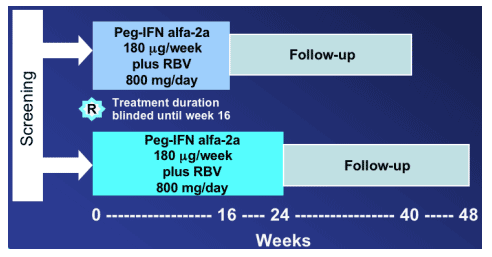
Background - ACCELERATE
ACCELERATE is the largest study ever conducted in HCV genotype 2/3 patients
Overall, ACCELERATE showed that 24 weeks of therapy (the current standard of care) is superior to 16 weeks.
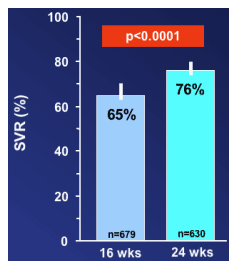
Shiffman M, et al. 41st EASL 2006; Abstract 734
Standard population
White vertical bars represent 95% confidence intervals
Summary of probability of SVR in patients treated for 24 weeks (standard pop; n=630).
Probability of SVR is better with younger age at treatment start, lower weight, when starting therapy with no cirrhosis, when ALT is higher, with genotype 2 compared to 3, and when HCV viral load is lower.
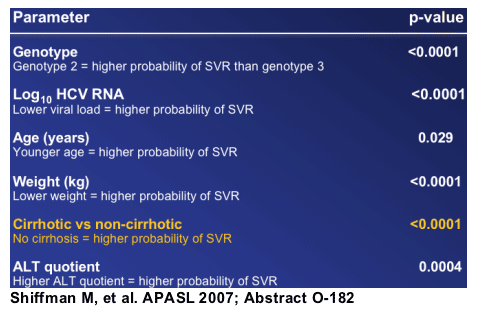
STUDY AIM
We analyzed data from the ACCELERATE trial in which genotype 2/3 patients received 16 or 24 weeks' peginterferon alfa-2a (40KD) plus ribavirin, to determine:
-- The impact of cirrhosis* on SVR, and
-- Whether optimizing treatment based on on-treatment virological response (RVR) is beneficial in these patients
*Cirrhosis included bridging fibrosis (Knodell ≥3, Metavir ≥3, or Ishak modified HAI score of 4 [with nodules or >3 bridges] or ≥5)
STUDY PATIENTS
--HCV genotype 2 or 3 infection
--Treatment naive
--Age ≥18 years
--HCV RNA (>600 IU/mL) in serum (COBAS AMPLICOR HCV Monitor Test, v2.0)
--Elevated ALT
--Liver biopsy consistent with a diagnosis of chronic hepatitis C within 24 months of study start
--Compensated liver disease (Child-Pugh Grade A)
CIRRHOSIS
In ACCELERATE, about 20% of patients were permitted to show clinical signs of cirrhosis or incomplete/ transition to cirrhosis
Patients were classified as either cirrhotic or non-cirrhotic according to the investigator
All patients with incomplete/transition to cirrhosis were categorized as cirrhotic
At baseline, 25% and 23% in the 16- and 24-week treatment groups, respectively, had compensated liver cirrhosis
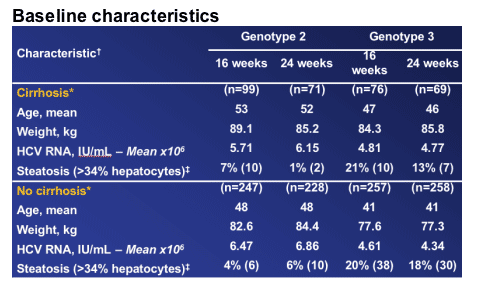
SVR by cirrhotic status
CIRRHOTICS: 16 weeks, 49% SVR; 24 weeks, 61%.
NO CIRRHOSIS: 16 weeks, 71%; 24 weeks, 80%
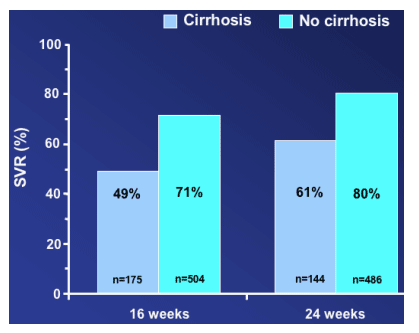
SVR by cirrhotic status and genotype
For patients with genotype 2 treatment for 24 weeks yielded better SVR rates compared to 16 weeks. For genotype 3 patients there appeared to be no difference between 16 and 24 weeks therapy. Also SVR rates were a little lower for patients with genotype 3 than 2.
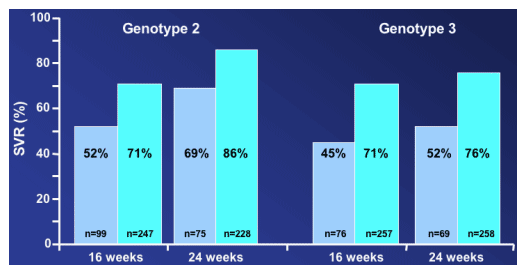
Undetectable HCV RNA at week 4 (RVR) by cirrhotic status
Cirrhotic patients had lower RVR rates 56% vs 71% for non-cirrhotic patients.
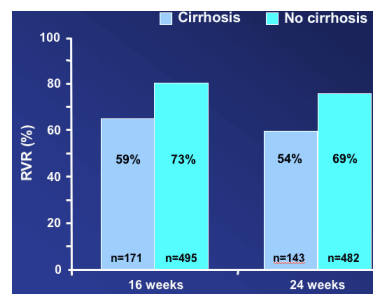
SVR in patients with an RVR
by cirrhotic status
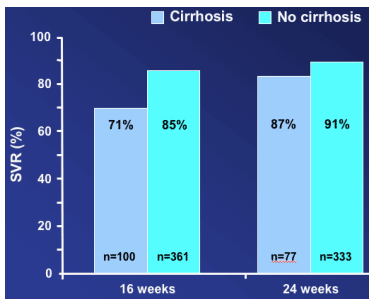
SVR in patients with an RVR by cirrhotic status and genotype
For genotype 2, 24 weeks therapy yielded better SVR rates for cirrhotics (72% vs 84%) and for non-cirrhotics (83% vs 93%). For genotype 3, 24 weeks therapy yielded better results for cirrhotics (93% vs 69%), but for non-cirrhotics 16 & 24 weeks therapy yielded similar results (87% for 16 wks, 89% for 24 wks).
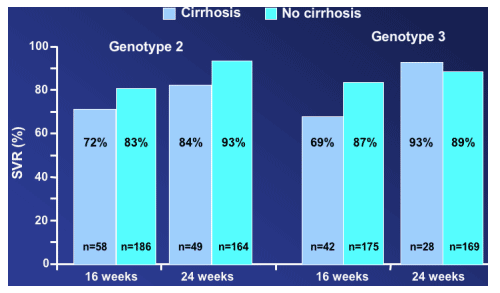
SVR in patients without an RVR
by cirrhotic status
Patients without an RVR did poorly with 16 and 24 weeks therapy. SVR rates with 16 or 24 weeks therapy were for cirrhotics: 16% with 16 wks and 30% with 24 wks; for non-cirrhotics, 16 wks therapy yielded 33% SVR rate and with 24 wks therapy SVR rate was 57%. The Willems study results presented at DDW & EASL show 48 weeks provide much better SVR rates for patients without RVR.
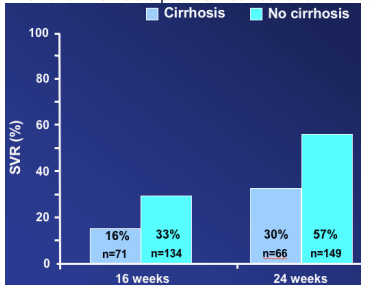
|
| |
|
 |
 |
|
|